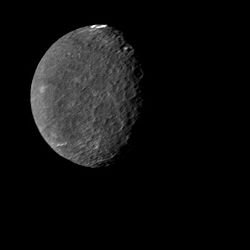
Umbriel or Uranus II is the sixteenth moon of Uranus in order of distance and the fourth moon of Uranus to be discovered.
William Lassell discovered Umbriel and its next companion, Ariel, on October 24, 1851, and reported his findings after observing these two satellites on three more occasions.[2][3]
The name Umbriel, suggested by Sir John Herschel at Lassell's request, is the name of an evil spirit in Alexander Pope's poem The Rape of the Lock.[5][6] The name is especially appropriate. Umbriel derives from the Latin umbra shadow, and Umbriel happens to be the darkest of all of Uranus' major moons.
Umbriel is in a slightly eccentric orbit around Uranus at an average distance of 266,300 km. Its sidereal month is about 4.14 Earth days. The orbit of Umbriel is only slightly inclined from the equator of Uranus but is severely inclined to the ecliptic.
Umbriel is in tidal lock with Uranus.
Umbriel is the fourth heaviest moon of Uranus, and slightly less dense than Ariel. Its density suggests that Umbriel is composed of water ice and rock.
The surface of Umbriel is covered with impact craters, most of which measure 100 to 200 km in diameter. Most astronomers believe that these craters formed early in the history of the solar system, during a period of heavy bombardment of many solar system bodies. The distribution of craters is uniform.[4]
Remarkably, the surface has no features suggesting any tectonic activity.[6][9] Moreover, Umbriel is the darkest and least reflective of all the major moons of Uranus.[8][4][6][10] Many astronomers suspect that Uranus is covered with a dark material similar to that which covers the Cassini Region of Iapetus. Some suspect that this material is methane.[9]
The most surprising feature of the surface of Umbriel is the bright ring, or Wunda ring, near the north pole. The nature and composition of that ring are unknown. The favorite theory is that it is the floor of a crater 40 km in diameter.[4][9]
The orbit of Umbriel is more eccentric than the orbit of Ariel. Yet Ariel shows signs of past tectonic activity, which some astronomers impute to tidal heating.[11] Umbriel's lack of any evidence of tidal heating is evidence against tidal heating for Ariel.
In addition, Umbriel poses the same problem for uniformitarian astronomy as do all the other moons of Uranus: its orbit is inclined severely to the ecliptic, though not to Uranus' own equator. How the Uranian system came to have such an inclination has never been explained.
Visiting mission::Voyager 2 approached to within 325,000 km of Umbriel on January 24, 1986, and took a small number of images.[12][13] No other detailed images are available.
 Browse |
|
|||||||||||||||||||||||||||||
|
||||||||||||||||||||